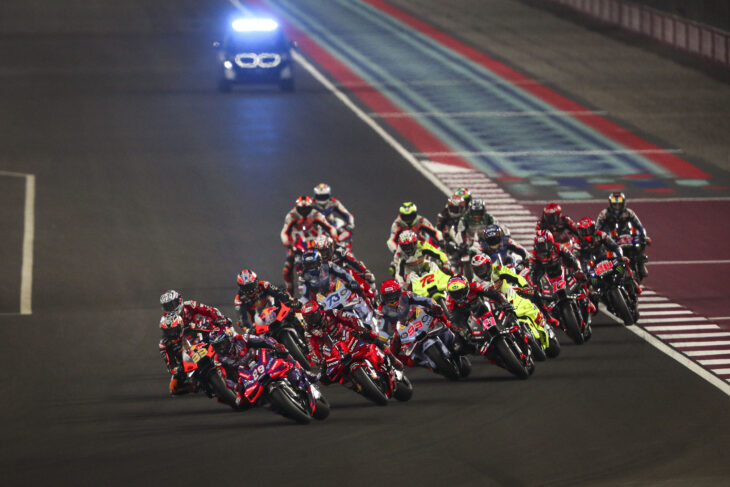Neil Morrison | May 6, 2024
After months of negotiation, MotoGP’s new technical regulations from 2027 were confirmed on Monday May 6, with a reduced engine capacity and control on aerodynamics chief among the upcoming changes.
Series organizers Dorna and MotoGP’s five manufacturers have long been concerned by the ever-increasing top speeds, as well as the considerable drop in lap times over recent years.
Regular tracks on the current calendar such as Mugello are believed to be at the limit in terms of safety. Those in charge believe Brad Binder’s top speed record during last year’s Sprint at the Italian venue of 227.4mph is too much, with gravel traps at certain circuits not big enough to cater for worst case scenarios. In effect, these new regulations are aimed at reining the MotoGP top brass in.
 The bikes will look very different with the new regulations announced today.
The bikes will look very different with the new regulations announced today.
That issue, as well as ensuring close competition, are chief among the aims of sweeping changes that will come into play once the current cycle of technical regulations come to an end at the close of 2026.
After switching to 1000cc four-stroke engines for 2012, the class will downsize to 850cc engines from 2027, with the maximum bore reduced from 81mm to 75mm, which is aimed at limiting performance. In two and a half years’ time, each rider and manufacturer will have six engines to last a season, rather than the current seven.
Aerodynamics have been a bug bear for many fans in recent years, as MotoGP machines have evolved from traditional looking racers to bikes straight out of a sci-fi film. As well as having a negative impact on racing by making overtaking more difficult, developing a winning aero package is demanding more investment and resources from each manufacturer.
Therefore, “The width of the top of the front fairing will be 50mm narrower and the nose will be pushed back 50mm, reducing the effect of aero where it matters, on the straights and the braking areas,” according to the new regulations. Also, any aero upgrades to the rear seat until will be controlled, with one update permitted per season, unlike present day when manufacturers can fit as many new wings to the seat unit as they please.
Ride-height and holeshot devices are other recent phenomena that have regularly come in for criticism for affecting racing and further simplifying a rider’s life. Both will be banned from 2027 with the aim of increasing the ability to overtake.
Fuel is another area of performance that will be addressed. The premier class switched to 40 percent sustainable fuel for this year, and saw next to no decrease in performance. For 2027, all MotoGP machines will race with 100 percent sustainable fuels. What’s more, fuel tank capacity is reduced from 22 liters to 20 (and eleven for Saturday’s Sprint race).
Intriguingly, GPS data was another area addressed in the new regulations. “To level the playing field even further, GPS data from all riders will be available to all teams after each session,” read the official statement. “Providing data to all competitors offers better opportunities to progress for the less performing teams and riders, and at a controlled cost. Access to this range of data will help make the sport safer, and it will also increase the level of insight available to fans around the world.”
To ensure close competition, the new regulations state all manufacturers will begin 2027 at Rank B in the current concession system (engine development frozen through the season, three designated test tracks and wildcards, and 190 test tires allocated), with performance then judged midseason to determine any changes.
This will represent the biggest shift in technical regulations since MotoGP switched to 1000cc capacity engines in 2012 after five years of dreary racing during the five-year 800cc era.